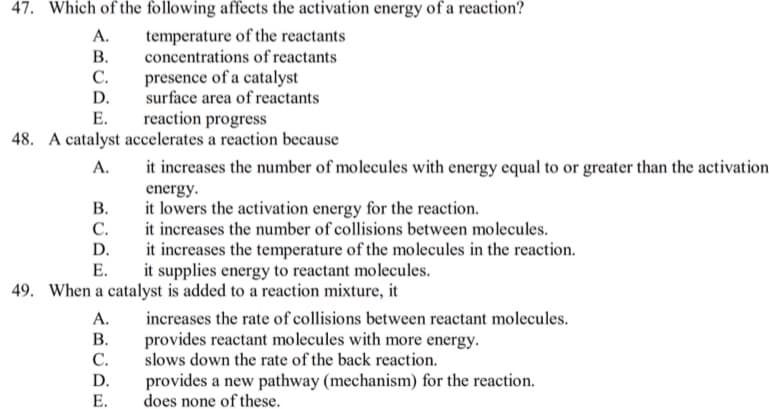47. Which of the following affects the activation energy of a reaction? temperature of the reactants concentrations of reactants А. В. presence of a catalyst surface area of reactants reaction progress C. D. Е.
47. Which of the following affects the activation energy of a reaction? temperature of the reactants concentrations of reactants А. В. presence of a catalyst surface area of reactants reaction progress C. D. Е.
Chemistry for Engineering Students
4th Edition
ISBN:9781337398909
Author:Lawrence S. Brown, Tom Holme
Publisher:Lawrence S. Brown, Tom Holme
Chapter11: Chemical Kinetics
Section: Chapter Questions
Problem 11.50PAE
Related questions
Question
kindly answer the following question below, choose the best answer. thank u so much

Transcribed Image Text:47. Which of the following affects the activation energy of a reaction?
А.
В.
С.
temperature of the reactants
concentrations of reactants
presence of a catalyst
surface area of reactants
D.
reaction progress
48. A catalyst accelerates a reaction because
Е.
А.
it increases the number of molecules with energy equal to or greater than the activation
energy.
В.
it lowers the activation energy for the reaction.
С.
it increases the number of collisions between molecules.
it increases the temperature of the molecules in the reaction.
it supplies energy to reactant molecules.
D.
Е.
49. When a catalyst is added to a reaction mixture, it
A.
increases the rate of collisions between reactant molecules.
В.
provides reactant molecules with more energy.
slows down the rate of the back reaction.
provides a new pathway (mechanism) for the reaction.
does none of these.
C.
D.
E.
Expert Solution
This question has been solved!
Explore an expertly crafted, step-by-step solution for a thorough understanding of key concepts.
This is a popular solution!
Trending now
This is a popular solution!
Step by step
Solved in 2 steps

Knowledge Booster
Learn more about
Need a deep-dive on the concept behind this application? Look no further. Learn more about this topic, chemistry and related others by exploring similar questions and additional content below.Recommended textbooks for you

Chemistry for Engineering Students
Chemistry
ISBN:
9781337398909
Author:
Lawrence S. Brown, Tom Holme
Publisher:
Cengage Learning


Chemistry
Chemistry
ISBN:
9781305957404
Author:
Steven S. Zumdahl, Susan A. Zumdahl, Donald J. DeCoste
Publisher:
Cengage Learning

Chemistry for Engineering Students
Chemistry
ISBN:
9781337398909
Author:
Lawrence S. Brown, Tom Holme
Publisher:
Cengage Learning


Chemistry
Chemistry
ISBN:
9781305957404
Author:
Steven S. Zumdahl, Susan A. Zumdahl, Donald J. DeCoste
Publisher:
Cengage Learning

Chemistry: An Atoms First Approach
Chemistry
ISBN:
9781305079243
Author:
Steven S. Zumdahl, Susan A. Zumdahl
Publisher:
Cengage Learning

Chemistry by OpenStax (2015-05-04)
Chemistry
ISBN:
9781938168390
Author:
Klaus Theopold, Richard H Langley, Paul Flowers, William R. Robinson, Mark Blaser
Publisher:
OpenStax

Chemistry & Chemical Reactivity
Chemistry
ISBN:
9781133949640
Author:
John C. Kotz, Paul M. Treichel, John Townsend, David Treichel
Publisher:
Cengage Learning